scattered travelogue day 4: breakfast in jail (Moab), nine thousand years on a sandstone cliff (Sego Canyon)
This is a part of my recent trip to Northeast corner of Utah and drive back and forth on I-70 from Denver, CO to Moab, UT.
"Traffic delay west of Idaho Springs. Alternative route advised" was all we had as an advance warning for what became a two-hour, ten-mile back up on the interstate 70.
The sunshine streaming through the eastward window of our "Victorian" room of the Center Street Hotel (I would say the room with grape-vined trellises on the ceiling was closer to being Roman than Victorian, and the shower room was slightly shabby, but it was a fun stay like a grab bag, especially for $39 a night.) was enough for us to get up at seven thirty, even after a more than full day of driving and hiking in the desiccating heat of Utah. Showered and packed up, we headed for breakfast at the breakfast-only Jailhouse Cafe. I contemplated on getting a "ginger pancake with Dutch apple butter," but gave in to a sudden rash of protein craving and got a chorizo omelet served with tortillas, homemade salsa fresca and sour cream. That certainly contained enough cholesterol for a month (which means it was tasty).
We crawled back in the car (a rented Chevy Cobalt, a new, upward-moving replacement for the Cavalier) and drove North on 191, through the breathtakingly colorful scenery of Utah, consisting only of rocks and soil of various colors and meager vegetation. After a brief drive on the I-70, we took a narrow winding road that cut through the alternatingly gray and yellow Thompson Canyon to see some petroglyphs left by thousands of years of Native Americans. Avoiding occasional suicidal kangaroo rats and slowing down for the cattle guards, it took us a few extra minutes. Upon glimpsing one of the several clusters of petroglyphs as we pulled into the small parking lot beneath the sandstone cliff, the bumpy drive immediately paid for itself.
Just above the parking lot on the side of a mustard-colored sandstone cliff, several realistic human figures and a few geometric symbols (such as two cocentric circles with two red bands) were clearly visible--among shameful graffiti scratched over them in the last hundred years, sadly enough. There were several others on the same cliff face, more sinisterly imaginative, a few yards ahead of the narrow road. An ominous, gorgon-like figure with rays radiating from its head and other dark, lobed figures roamed, as if approaching from behind the thick smoke of the end of the world. The drawings were chill-evoking in two ways: for one, it was absolutely fascinating to think that those figures were drawn by people of 9000 years ago and had survived all the erosion and destruction, and for another, they definitely revealed (or so it felt) the dark side of the human imagination, apparent in many mythology and religion with doomsday scenario. On the other side of the narrow road, above a fenced cattle area with still-moist heaps of dung, two more clusters of petroglyphs, each from a wildly different era, awaited us. One was mainly realistic drawings of people, animals and hunting, and the other was ominous, gloomy drawings similar to the second cluster. Shaking my head at the funny absurdity of keeping a cattle herd right under an archeological site of 9000 years, I took pictures as if it would matter as a historical document, as if no one else had ever photographed them before.
imaginative, rimless figures, dating back to 2000 B.C., followed a long period of traditional, realistic representation of hunting/gathering life
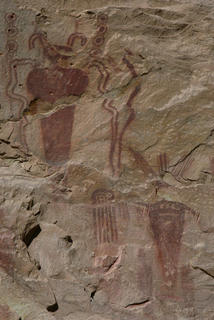
hollow eyes add to the creepiness, also from 200 B.C.
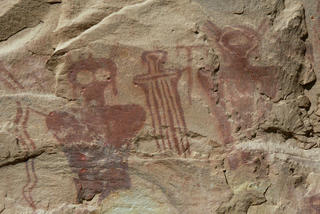
a mysterious figure reminiscent of a monkey, which shouldn't have been around in the U.S. at the time of drawing
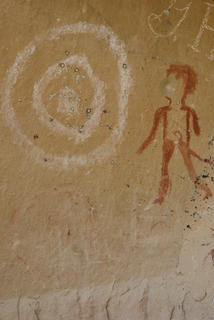
soldiers of doom appear from behind a thick wall of leathal smoke... also from 2000 B.C.
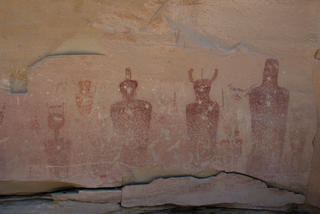
these figures of inversed triangle were engraved around 600 A.D., before the style returned to the traditional, realistic one

What's fascinating was the shift in style back and forth over time. More specifically, the apparent flourish of imaginative, unrealistic styles sandwitched between more traditional, realistic depiction of the lives of the Native Americans. The petroglyphs dated around 7000 B.C. and ones after 1300 A.D. are within the range of normal expectations for prehistoric drawings on a cliff or in a cave, featuring hunters with bows and arrows, game animals such as deer, and babies bundled up tightly in rag clothes. In contrast, the ones from 2000 B.C. and 500 A.D. include abstract symbols and ominous-looking god/human figures, reminiscent of an evil anime character of some sort, that are well beyond our normal expectation. I'm not familiar enough with the history of the region to fathom the relationships between each group of Native Americans that left the radically different petroglyphs, but I wonder how connected or disconnected they were to each other and what brought forth the change in their styles.
(to be continued)
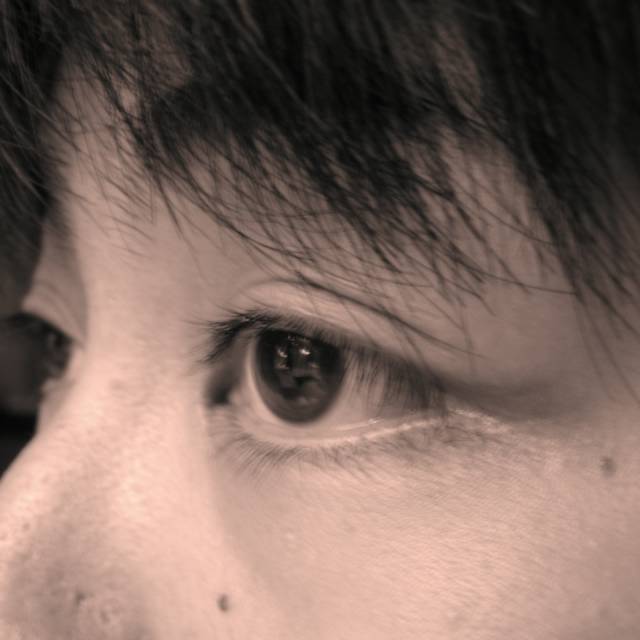


0 Comments:
Post a Comment
<< Home